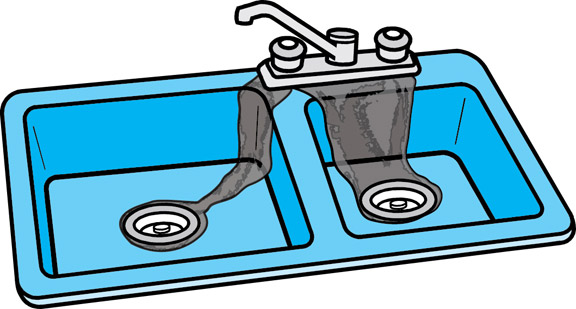Iron In Water Supplies: The Good, The Bad, And The Ugly
Iron is commonly found in concentrations ranging from 0.01–10.0 parts per million (ppm) in our water supplies. It can come from either natural sources such as igneous rocks and clay minerals or the corrosion of iron or steel surfaces. Iron exists in either the ferrous (Fe2+) or ferric (Fe3+) state. Together these states are measured as total iron.
In the absence of oxygen, ferrous iron is quite soluble. But in a pH range of 7.0–8.5, iron is almost completely insoluble in the presence of oxygen: then it will precipitate as iron oxide (the ferric state).
As a micromineral, iron is essential for the health of both plants and animals. In humans, it’s necessary for transporting oxygen and regulating cell growth. A trace level of iron—under 0.3 ppm—in potable water is therefore beneficial. That is the good.
When water containing more than a trace of iron is used for domestic purposes, though, its presence is troublesome. (The problem water is usually from a well as municipal water has been treated.) Reddish-brown stains on plumbed fixtures and appliances and discolored laundry often result. It can also impart an undesirable astringent taste to beverages and foods. That is the bad.
In a utility or commercial/industrial setting, however, iron in the water can have severe economic repercussions. Not only will it cause staining of surfaces and finished products, it promotes the growth of harmful bacteria, reduces flow in distribution piping, contributes to corrosion, and creates deposits on critical heat-transfer surfaces, increasing energy costs and leading ultimately to expensive downtime for removal, repair, or replacement. That is the ugly.
Challenges Posed by Iron in the Water
Let's take a closer look at some iron-related problems operators and their water treatment vendors face:
- Staining is an ongoing challenge in the pulp and paper, printing, laundry, textile, and canning industries where an unblemished appearance means everything to a saleable product.
- Industrial as well as municipal water distribution piping can suffer flow loss due to iron-loving bacteria. These iron bacteria metabolize soluble ferrous iron to insoluble ferric iron then excrete it. The deposits can accumulate to the extent plugging occurs. The bacterial colonies will trap suspended debris and serve as a matrix for calcium carbonate (CaCO3) and iron carbonate (FeCO3) scale, exacerbating the problem.
- Similarly, fouling will occur in cooling systems where iron bacteria thrive. Microbiologically induced corrosion of steel can also be caused by iron bacteria.
- Iron in a boiler or cooling water analysis is a sign of corrosion in the system.
- Heat transfer is inhibited in boiler systems due to the formation of scales, a number of which are iron based such as ferrous oxide, magnetite, and hematite. Just 3/8" of scale in or on boiler tubes can cause heat transfer losses requiring up to a 55% increase in fuel consumption to overcome. In severe cases the boiler tubes can overheat and rupture, meaning loss of production and a big hit to the capital equipment budget.
- When iron is part of the deposit matrix, the scale is denser and harder to remove.
Treatment Begins with Testing
The color standards are housed in a heavy-duty molded-plastic comparator. Value-priced Midget™ comparators are the perfect choice for field testing when color or turbidity are not present in the sample, or have been filtered out before the test begins. Approximately 3.5" w x 3.75" h x 1.75" d, each Midget contains eight liquid-color standards. The larger Slide™ comparator (about 10" w x 4" h x 2.25" d) holds nine color standards and is designed to compensate for any color or turbidity in the sample. Taylor’s Long Viewpath™ comparator is very similar to the Slide except a longer test cell, mirrored at one end, increases test sensitivity.
Reasonable care—do not drop, leave out in the sun, or let freeze—will yield many years of service. Small operators and water treatment companies whose budgets preclude electronic colorimeters will especially find these tests attractive.
Your Choices Summarized
| Iron Kit No. | System | Method | Color Standards | No. Tests |
|---|---|---|---|---|
| K-1716 | Midget | Total by TPTZ | 0, 0.2, 0.4, 0.6, 0.8, 1.0, 1.5, 2.0 ppm Fe | 44 |
| K-1153 | Slide | Total by TPTZ | 0, 0.1, 0.2, 0.3, 0.4, 0.6, 0.8, 1.0, 2.0 ppm Fe | 120 |
| K-1154 | Slide | Total by Phenanthroline | 0, 0.5, 1.0, 2.0, 3.0, 4.0, 6, 8, 10 ppm Fe | 58 |
In the phenanthroline method, the total iron is determined by reducing ferric iron to ferrous iron which then reacts with phenanthroline to produce an orange-red complex. The TPTZ method, useful for low iron levels, utilizes the purple complex formed in the reaction of ferrous iron with 2,4,6-tripyridyl-s-triazine.


